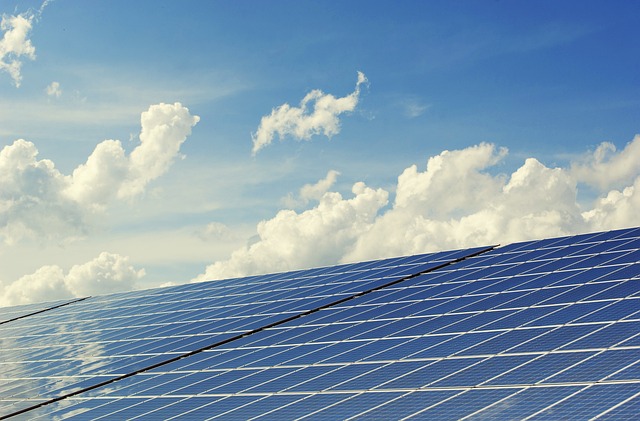“Power Your Future: Seamlessly Integrate Solar Inverters with Wind Energy Systems for Maximum Efficiency.”
Integrating a solar inverter with wind energy systems involves combining two renewable energy sources to create a more efficient and reliable power generation system. This integration allows for the optimization of energy production by harnessing solar power during sunny periods and wind energy during breezy conditions. The process requires careful consideration of system compatibility, including the inverter’s ability to handle varying input voltages and frequencies from both sources. Additionally, proper energy management systems must be implemented to ensure seamless operation, maximize energy output, and maintain grid stability. This introduction outlines the key steps and considerations for effectively integrating solar inverters with wind energy systems, paving the way for a sustainable and resilient energy future.
Benefits of Combining Solar Inverters with Wind Energy Systems
The integration of solar inverters with wind energy systems presents a compelling opportunity for enhancing renewable energy generation. By combining these two technologies, users can harness the strengths of both solar and wind power, leading to a more reliable and efficient energy system. One of the primary benefits of this integration is the ability to provide a more consistent energy output. Solar energy generation is often intermittent, heavily influenced by weather conditions and time of day. Conversely, wind energy can be more variable, depending on local wind patterns. When these two systems are combined, they can complement each other, ensuring that energy production is more stable throughout the day and across different seasons.
Moreover, the combination of solar inverters with wind energy systems can lead to increased overall energy efficiency. Solar inverters are designed to convert the direct current (DC) generated by solar panels into alternating current (AC), which is the form of electricity used in homes and businesses. When integrated with wind turbines, these inverters can also manage the variable output from wind energy, optimizing the conversion process and ensuring that the energy produced is used effectively. This dual functionality not only maximizes energy capture but also minimizes losses, making the entire system more efficient.
In addition to efficiency, the integration of these technologies can significantly reduce energy costs for consumers. By generating power from both solar and wind sources, users can decrease their reliance on grid electricity, leading to lower utility bills. Furthermore, during periods of high energy production, excess electricity can be stored or sold back to the grid, creating additional financial benefits. This economic advantage is particularly pronounced in regions where incentives for renewable energy generation are available, such as tax credits or feed-in tariffs, which can further enhance the return on investment for combined systems.
Another noteworthy benefit of integrating solar inverters with wind energy systems is the environmental impact. By utilizing renewable energy sources, users contribute to the reduction of greenhouse gas emissions and the overall carbon footprint. This is increasingly important in the context of global climate change, as transitioning to cleaner energy sources is essential for sustainable development. The synergy between solar and wind energy not only promotes environmental stewardship but also supports energy independence, reducing reliance on fossil fuels and enhancing energy security.
Furthermore, the technological advancements in both solar and wind energy systems have made integration more feasible and efficient than ever before. Modern solar inverters are equipped with sophisticated software that allows for real-time monitoring and management of energy production from multiple sources. This capability enables users to optimize their energy systems dynamically, adjusting to changing conditions and maximizing output. As technology continues to evolve, the integration of solar and wind energy systems is likely to become even more streamlined, offering greater benefits to users.
In conclusion, the combination of solar inverters with wind energy systems offers a multitude of advantages, including enhanced energy stability, increased efficiency, reduced costs, and a positive environmental impact. As the demand for renewable energy continues to grow, exploring these integrated systems will be crucial for achieving a sustainable energy future. By leveraging the strengths of both solar and wind power, users can create a more resilient and efficient energy solution that meets their needs while contributing to a cleaner planet.
Key Considerations for Integrating Solar and Wind Energy Technologies

Integrating solar and wind energy technologies presents a unique opportunity to enhance renewable energy systems, but it also requires careful consideration of several key factors. First and foremost, understanding the characteristics of both energy sources is essential. Solar energy is typically more predictable during daylight hours, while wind energy can be more variable, depending on weather conditions. This variability necessitates a robust energy management system that can effectively balance the two sources, ensuring a consistent power supply.
One of the primary considerations when integrating a solar inverter with wind energy systems is the compatibility of the technologies involved. Solar inverters are designed to convert direct current (DC) generated by solar panels into alternating current (AC) for use in homes and businesses. In contrast, wind turbines generate AC power directly, which may require additional conversion depending on the system design. Therefore, selecting an inverter that can handle inputs from both solar panels and wind turbines is crucial. This often involves using a hybrid inverter or a multi-input inverter that can seamlessly manage the different energy sources.
Moreover, the sizing of both the solar and wind components is vital for optimal performance. It is important to conduct a thorough analysis of the energy needs of the system and the expected output from both sources. This analysis should take into account local weather patterns, seasonal variations, and the specific energy demands of the application. By accurately sizing the solar panels and wind turbines, one can ensure that the system operates efficiently and meets energy requirements without overloading the inverter.
In addition to sizing, the placement of solar panels and wind turbines plays a significant role in the overall efficiency of the integrated system. Solar panels should be positioned to maximize sunlight exposure, while wind turbines need to be located in areas with consistent wind flow. This often requires a detailed site assessment to identify the best locations for each technology. Furthermore, the integration of these systems should consider potential shading from nearby structures or trees that could impact solar performance, as well as the height and spacing of wind turbines to minimize turbulence and maximize energy capture.
Another critical aspect of integration is the control strategy employed to manage the output from both energy sources. An effective control system can optimize the use of solar and wind energy, ensuring that the inverter operates within its limits while maximizing energy production. This may involve implementing advanced algorithms that can predict energy generation based on weather forecasts and adjust the system’s operation accordingly. Additionally, incorporating energy storage solutions, such as batteries, can further enhance the reliability of the system by storing excess energy generated during peak production times for use during periods of low generation.
Finally, regulatory and grid connection considerations must not be overlooked. Different regions have varying regulations regarding the interconnection of renewable energy systems to the grid. It is essential to understand these regulations and ensure compliance to avoid potential penalties or operational issues. Engaging with local utility companies early in the planning process can facilitate a smoother integration and help identify any specific requirements for connecting a hybrid solar and wind energy system to the grid.
In conclusion, integrating solar inverters with wind energy systems involves a multifaceted approach that considers compatibility, sizing, placement, control strategies, and regulatory compliance. By addressing these key considerations, one can create a more resilient and efficient renewable energy system that harnesses the strengths of both solar and wind technologies, ultimately contributing to a more sustainable energy future.
Step-by-Step Guide to Setting Up a Hybrid Solar-Wind Energy System
Integrating a solar inverter with wind energy systems to create a hybrid energy solution is an increasingly popular approach for maximizing renewable energy generation. This combination not only enhances energy reliability but also optimizes the use of available resources. To successfully set up a hybrid solar-wind energy system, it is essential to follow a systematic step-by-step guide that ensures efficiency and effectiveness.
First and foremost, the initial step involves assessing your energy needs. Understanding your household or facility’s energy consumption patterns is crucial, as it will inform the size and capacity of both the solar panels and wind turbines required for your system. By analyzing your energy bills and identifying peak usage times, you can determine the appropriate specifications for your hybrid system. This assessment will also help you decide on the ratio of solar to wind energy, which can vary based on geographic location and seasonal weather patterns.
Once you have a clear understanding of your energy requirements, the next step is to select the appropriate components for your hybrid system. This includes choosing high-quality solar panels, a compatible wind turbine, and a solar inverter that can handle the combined output of both energy sources. It is important to ensure that the inverter is capable of managing the variable input from both solar and wind sources, as this will be critical for maintaining system efficiency. Additionally, consider incorporating a battery storage system to store excess energy generated during peak production times, which can then be used during periods of low generation.
After selecting the components, the next phase involves designing the layout of your hybrid system. This includes determining the optimal placement of solar panels and wind turbines to maximize energy capture. Solar panels should ideally be installed in a location that receives direct sunlight for most of the day, while wind turbines should be positioned in areas with consistent wind flow, away from obstructions that could impede performance. Proper spacing between the two systems is also essential to prevent shading of the solar panels by the wind turbine.
With the design in place, you can proceed to the installation phase. Begin by installing the solar panels on a suitable mounting structure, ensuring they are securely fastened and angled correctly to capture maximum sunlight. Next, install the wind turbine according to the manufacturer’s guidelines, paying close attention to height and orientation to optimize wind capture. During this process, it is crucial to follow all local regulations and safety standards, which may require obtaining permits or inspections.
Once both systems are installed, the next step is to connect them to the solar inverter. This involves wiring the solar panels and wind turbine to the inverter, ensuring that all connections are secure and compliant with electrical codes. It is advisable to consult with a professional electrician or renewable energy expert during this phase to ensure that the integration is done safely and correctly.
Finally, after all components are connected, conduct thorough testing of the system to ensure everything is functioning as intended. Monitor the performance of both the solar and wind components, as well as the inverter, to identify any issues that may arise. Regular maintenance and monitoring will help optimize the performance of your hybrid system over time, allowing you to enjoy the benefits of renewable energy while contributing to a more sustainable future.
In conclusion, integrating a solar inverter with wind energy systems requires careful planning, selection of appropriate components, and meticulous installation. By following these steps, you can create a reliable and efficient hybrid energy system that harnesses the power of both the sun and wind, ultimately leading to reduced energy costs and a smaller carbon footprint.
Common Challenges in Solar and Wind Energy Integration and Solutions
Integrating solar inverters with wind energy systems presents a unique set of challenges that require careful consideration and innovative solutions. One of the primary challenges is the variability of both solar and wind resources. Solar energy generation is heavily dependent on sunlight, which fluctuates throughout the day and is affected by weather conditions. Similarly, wind energy generation is influenced by wind speed and direction, which can change rapidly. This inherent variability can lead to difficulties in maintaining a stable and reliable energy output, particularly when trying to synchronize the two energy sources.
To address this challenge, energy storage systems, such as batteries, can play a crucial role. By storing excess energy generated during peak production times, these systems can provide a buffer against fluctuations in energy supply. For instance, when solar output is high during sunny days, the surplus energy can be stored and then released during periods of low generation, such as at night or during cloudy weather. Similarly, when wind energy production is high, the stored energy can be utilized to meet demand when both sources are underperforming. This approach not only enhances reliability but also maximizes the utilization of renewable resources.
Another significant challenge in integrating solar inverters with wind energy systems is the difference in the operational characteristics of the two technologies. Solar inverters typically convert direct current (DC) generated by solar panels into alternating current (AC) for use in the grid, while wind turbines generate AC directly. This difference necessitates the use of advanced control systems to ensure that the two energy sources can work together seamlessly. Implementing a hybrid inverter that can handle both solar and wind inputs can simplify this integration process. These hybrid inverters are designed to manage the varying characteristics of both energy sources, allowing for more efficient energy conversion and distribution.
Moreover, grid compatibility poses another challenge. The integration of solar and wind energy systems must comply with grid standards to ensure that the energy produced is compatible with existing infrastructure. This often requires the installation of additional equipment, such as power conditioning systems, to manage power quality and ensure that voltage and frequency remain within acceptable limits. By investing in smart grid technologies, operators can enhance the ability of the grid to accommodate diverse energy inputs, thus facilitating smoother integration of solar and wind systems.
In addition to technical challenges, regulatory and financial barriers can also hinder the integration of solar and wind energy systems. Different regions may have varying policies regarding renewable energy generation, which can complicate project development. To overcome these barriers, stakeholders must engage in proactive dialogue with regulatory bodies to advocate for supportive policies that promote the integration of renewable energy sources. Furthermore, securing financing for hybrid projects can be challenging, but innovative financing models, such as power purchase agreements (PPAs) or community solar initiatives, can provide viable pathways for investment.
Ultimately, while the integration of solar inverters with wind energy systems presents several challenges, these obstacles can be effectively addressed through a combination of technological innovation, strategic planning, and collaborative efforts among stakeholders. By leveraging energy storage solutions, hybrid inverters, smart grid technologies, and supportive regulatory frameworks, it is possible to create a more resilient and efficient renewable energy landscape. As the demand for clean energy continues to grow, overcoming these challenges will be essential for maximizing the potential of both solar and wind resources in a sustainable energy future.
Q&A
1. **Question:** What is the primary function of a solar inverter in a wind energy system?
**Answer:** The primary function of a solar inverter in a wind energy system is to convert the direct current (DC) generated by solar panels into alternating current (AC) that can be used by the grid or local loads, while also managing the integration of energy from both solar and wind sources.
2. **Question:** What components are necessary for integrating a solar inverter with a wind energy system?
**Answer:** Necessary components include a solar inverter, a wind turbine inverter (if applicable), a hybrid controller or energy management system, battery storage (optional), and appropriate wiring and safety devices.
3. **Question:** How can energy management systems optimize the use of solar and wind energy together?
**Answer:** Energy management systems can optimize the use of solar and wind energy by monitoring generation from both sources, managing battery storage, and controlling the load to ensure efficient energy distribution and minimize waste.
4. **Question:** What are the benefits of integrating solar inverters with wind energy systems?
**Answer:** Benefits include increased energy reliability, reduced dependence on fossil fuels, improved energy efficiency, and the ability to harness complementary generation patterns, as solar and wind resources often peak at different times.
Conclusion
Integrating a solar inverter with wind energy systems involves several key steps: ensuring compatibility between the inverter and the wind turbine’s output, using a hybrid inverter that can handle both solar and wind inputs, and implementing a proper energy management system to optimize the use of generated power. Additionally, careful consideration of system design, including battery storage options and grid connection, is essential for maximizing efficiency and reliability. Ultimately, a well-integrated system can enhance energy production, reduce reliance on fossil fuels, and contribute to a more sustainable energy future.



